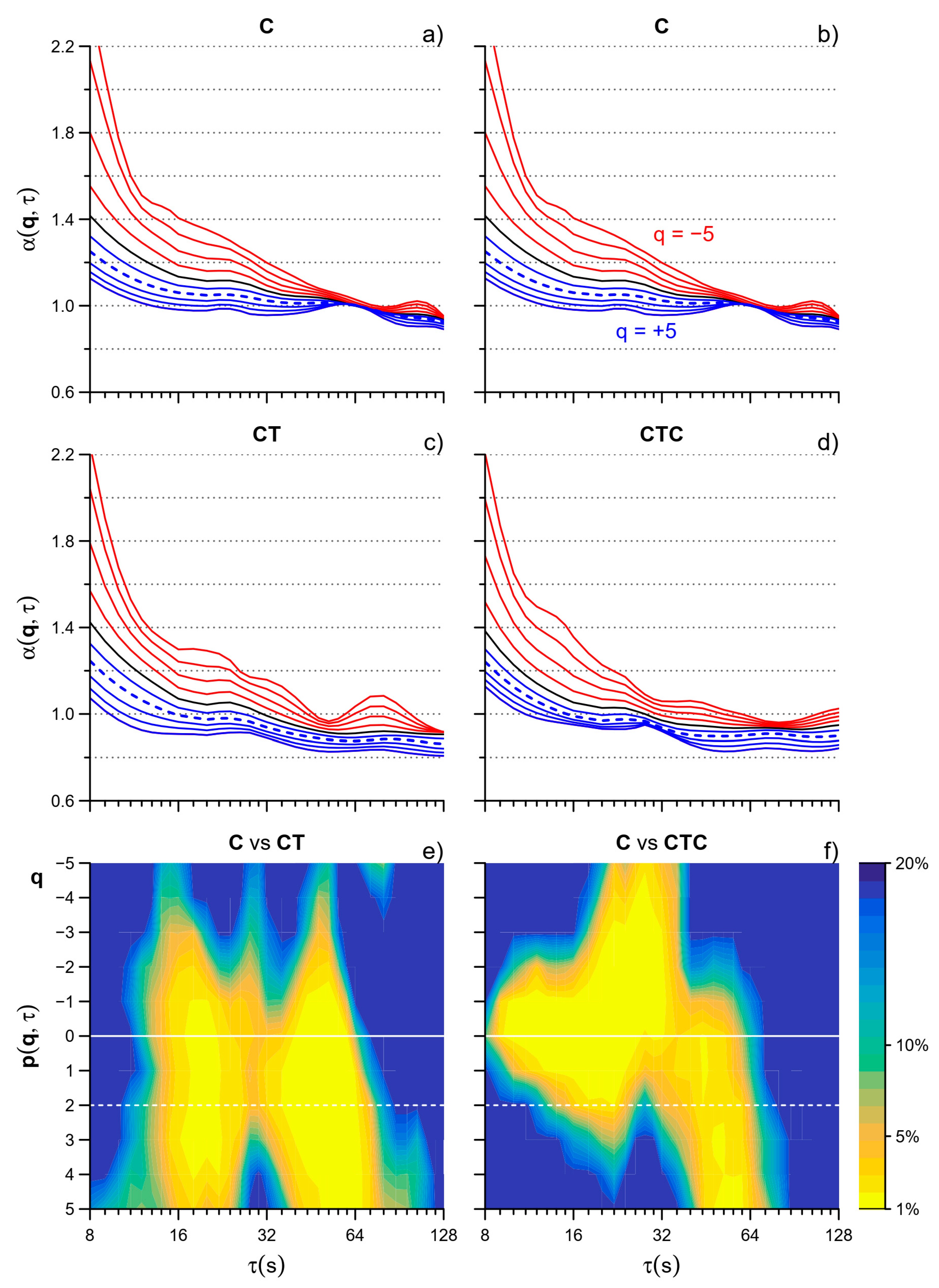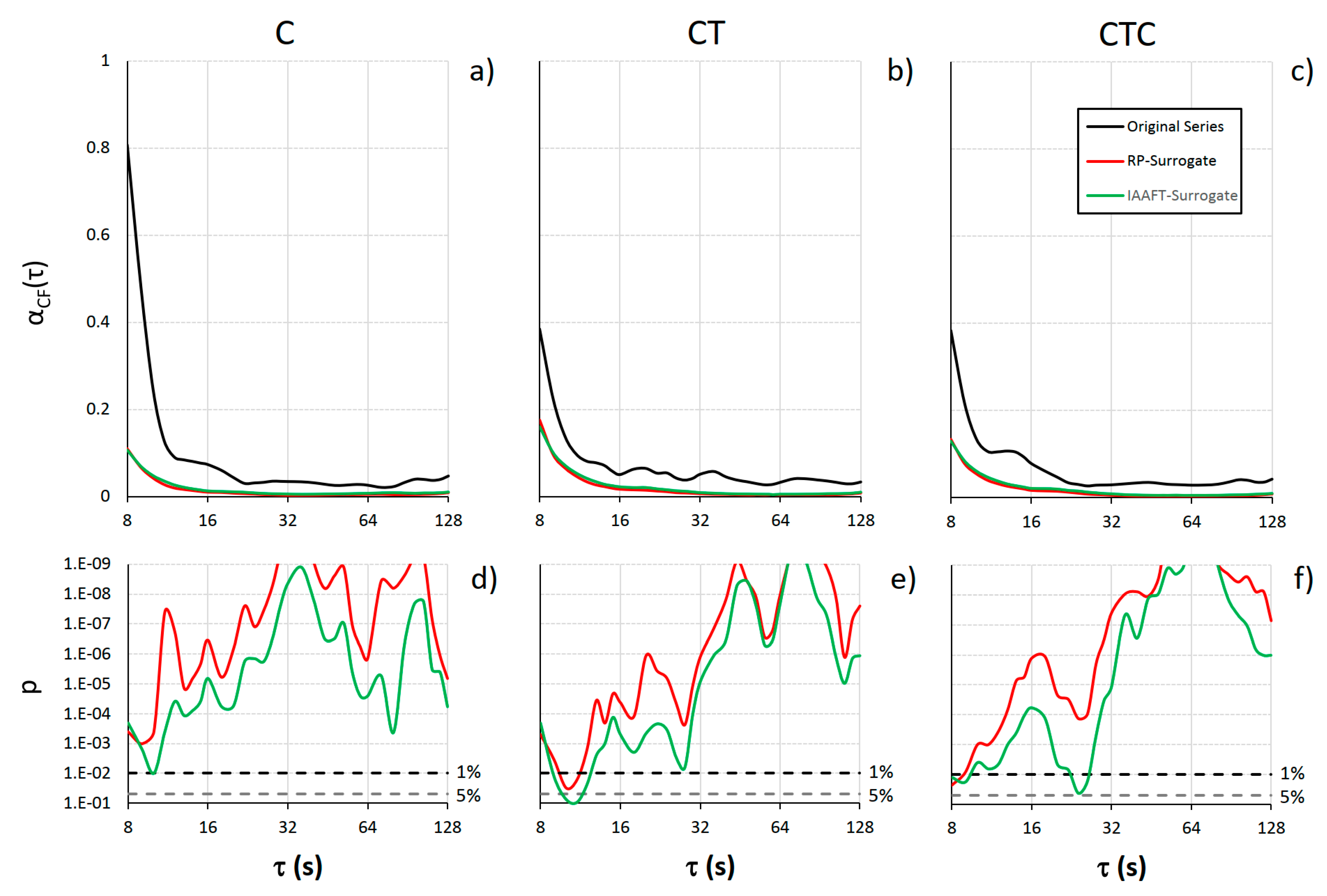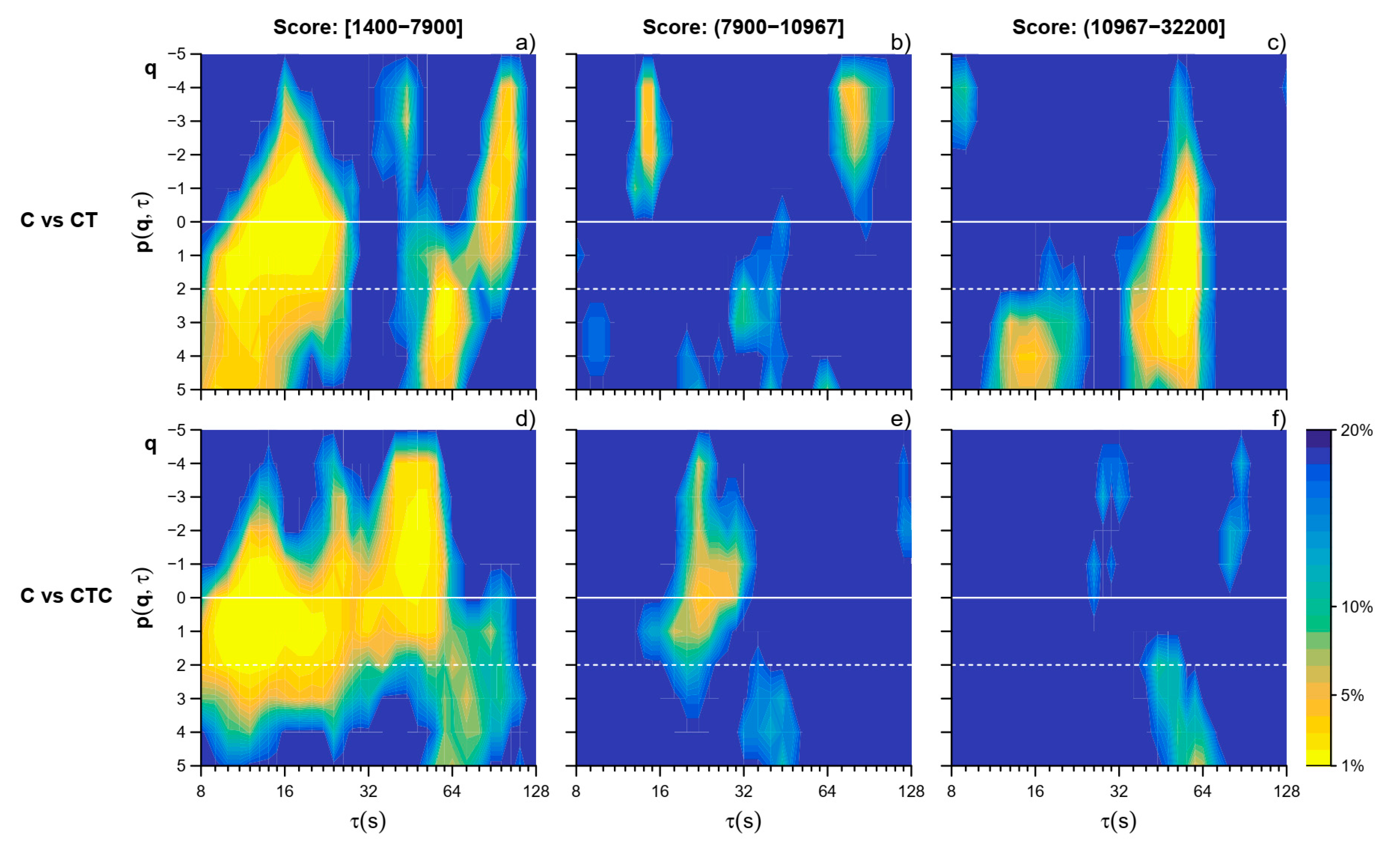Multifractal Multiscale Analysis of Human Movements during Cognitive Tasks
Abstract
1. Introduction
2. Materials and Methods
2.1. Subjects and Data Collection
2.2. Multifractal Multiscale DFA
2.2.1. Estimation of Multifractal Multiscale Coefficients
2.2.2. Statistical Comparison with the Reference Condition
2.3. Degree of Multifractality Scale by Scale
2.3.1. Cumulative Multifractality Function
2.3.2. Surrogate Data Analysis
2.3.3. Statistical Comparison with the Surrogate Data
3. Results
3.1. MFMS-DFA and Cognitive Tasks
3.2. Multifractality
3.3. Stratification by Skill Level
4. Discussion and Conclusions
Limitations
Author Contributions
Funding
Institutional Review Board Statement
Data Availability Statement
Conflicts of Interest
Appendix A


References
- Ihlen, E.A.F.; Vereijken, B. Multifractal Formalisms of Human Behavior. Hum. Mov. Sci. 2013, 32, 633–651. [Google Scholar] [CrossRef] [PubMed]
- Dixon, J.A.; Holden, J.G.; Mirman, D.; Stephen, D.G. Multifractal Dynamics in the Emergence of Cognitive Structure. Top. Cogn. Sci. 2012, 4, 51–62. [Google Scholar] [CrossRef] [PubMed]
- Shimizu, Y.; Thurner, S.; Ehrenberger, K. Multifractal spectra as a measure of complexity in human posture. Fractals 2002, 10, 103–116. [Google Scholar] [CrossRef]
- Wilson, T.J.; Mangalam, M.; Stergiou, N.; Likens, A.D. Multifractality in Stride-to-Stride Variations Reveals That Walking Involves More Movement Tuning and Adjusting than Running. Front. Netw. Physiol. 2023, 3, 1294545. [Google Scholar] [CrossRef] [PubMed]
- Peng, C.K.; Havlin, S.; Hausdorff, J.M.; Mietus, J.E.; Stanley, H.E.; Goldberger, A.L. Fractal Mechanisms and Heart Rate Dynamics. Long-Range Correlations and Their Breakdown with Disease. J. Electrocardiol. 1995, 28, 59–65. [Google Scholar] [CrossRef] [PubMed]
- Kantelhardt, J.W.; Zschiegner, S.A.; Koscielny-Bunde, E.; Havlin, S.; Bunde, A.; Stanley, H.E. Multifractal Detrended Fluctuation Analysis of Nonstationary Time Series. Phys. A Stat. Mech. Appl. 2002, 316, 87–114. [Google Scholar] [CrossRef]
- Mukli, P.; Nagy, Z.; Eke, A. Multifractal Formalism by Enforcing the Universal Behavior of Scaling Functions. Phys. A Stat. Mech. Appl. 2015, 417, 150–167. [Google Scholar] [CrossRef]
- Pratviel, Y.; Deschodt-Arsac, V.; Larrue, F.; Arsac, L.M. Fast Hand Movements Unveil Multifractal Roots of Adaptation in the Visuomotor Cognitive System. Front. Physiol. 2021, 12, 713076. [Google Scholar] [CrossRef]
- Delignières, D.; Almurad, Z.M.H.; Roume, C.; Marmelat, V. Multifractal Signatures of Complexity Matching. Exp. Brain Res. 2016, 234, 2773–2785. [Google Scholar] [CrossRef][Green Version]
- Gilfriche, P.; Deschodt-Arsac, V.; Blons, E.; Arsac, L.M. Frequency-Specific Fractal Analysis of Postural Control Accounts for Control Strategies. Front. Physiol. 2018, 9, 293. [Google Scholar] [CrossRef]
- Delignières, D.; Marmelat, V. Strong Anticipation and Long-Range Cross-Correlation: Application of Detrended Cross-Correlation Analysis to Human Behavioral Data. Phys. A Stat. Mech. Appl. 2014, 394, 47–60. [Google Scholar] [CrossRef]
- Castiglioni, P.; Faini, A. A Fast DFA Algorithm for Multifractal Multiscale Analysis of Physiological Time Series. Front. Physiol. 2019, 10, 115. [Google Scholar] [CrossRef] [PubMed]
- Faini, A.; Parati, G.; Castiglioni, P. Multiscale Assessment of the Degree of Multifractality for Physiological Time Series. Phil. Trans. R. Soc. A. 2021, 379, 20200254. [Google Scholar] [CrossRef] [PubMed]
- Castiglioni, P.; Omboni, S.; Parati, G.; Faini, A. Day and Night Changes of Cardiovascular Complexity: A Multi-Fractal Multi-Scale Analysis. Entropy 2020, 22, 462. [Google Scholar] [CrossRef] [PubMed]
- Pashler, H. Dual-Task Interference in Simple Tasks: Data and Theory. Psychol. Bull. 1994, 116, 220–244. [Google Scholar] [CrossRef] [PubMed]
- Strobach, T. Cognitive Control and Meta-Control in Dual-Task Coordination. Psychon. Bull. Rev. 2023. [Google Scholar] [CrossRef] [PubMed]
- Wing, A.M.; Kristofferson, A.B. The Timing of Interresponse Intervals. Percept. Psychophys. 1973, 13, 455–460. [Google Scholar] [CrossRef]
- Arsac, L.M. Multifractal Dynamics in Executive Control When Adapting to Concurrent Motor Tasks. Front. Physiol. 2021, 12, 662076. [Google Scholar] [CrossRef]
- Breukelaar, R.; Demaine, E.D.; Hohenberger, S.; Hoogeboom, H.J.; Kosters, W.A.; Liben-Nowell, D. Tetris is hard, even to approximate. Int. J. Comput. Geom. Appl. 2004, 14, 41–68. [Google Scholar] [CrossRef]
- Hart, S.G.; Staveland, L.E. Development of NASA-TLX (Task Load Index): Results of Empirical and Theoretical Research. In Advances in Psychology; Elsevier: Amsterdam, The Netherlands, 1988; Volume 52, pp. 139–183. ISBN 978-0-444-70388-0. [Google Scholar]
- Almurad, Z.M.H.; Delignières, D. Evenly Spacing in Detrended Fluctuation Analysis. Phys. A Stat. Mech. Appl. 2016, 451, 63–69. [Google Scholar] [CrossRef]
- Kantelhardt, J.W.; Koscielny-Bunde, E.; Rego, H.H.A.; Havlin, S.; Bunde, A. Detecting Long-Range Correlations with Detrended Fluctuation Analysis. Phys. A Stat. Mech. Appl. 2001, 295, 441–454. [Google Scholar] [CrossRef]
- Bunde, A.; Havlin, S.; Kantelhardt, J.W.; Penzel, T.; Peter, J.-H.; Voigt, K. Correlated and Uncorrelated Regions in Heart-Rate Fluctuations during Sleep. Phys. Rev. Lett. 2000, 85, 3736–3739. [Google Scholar] [CrossRef] [PubMed]
- Lancaster, G.; Iatsenko, D.; Pidde, A.; Ticcinelli, V.; Stefanovska, A. Surrogate Data for Hypothesis Testing of Physical Systems. Phys. Rep. 2018, 748, 1–60. [Google Scholar] [CrossRef]
- Makowiec, D.; Rynkiewicz, A.; Wdowczyk-Szulc, J.; Zarczynska-Buchowiecka, M.; Galaska, R.; Kryszewski, S. Aging in Autonomic Control by Multifractal Studies of Cardiac Interbeat Intervals in the VLF Band. Physiol. Meas. 2011, 32, 1681–1699. [Google Scholar] [CrossRef]
- Watanabe, K.; Funahashi, S. Neural Mechanisms of Dual-Task Interference and Cognitive Capacity Limitation in the Prefrontal Cortex. Nat. Neurosci. 2014, 17, 601–611. [Google Scholar] [CrossRef]
- Hu, K.; Ivanov, P.C.; Chen, Z.; Carpena, P.; Stanley, H.E. Effect of Trends on Detrended Fluctuation Analysis. Phys. Rev. E Stat. Nonlin. Soft. Matter. Phys. 2001, 64, 011114. [Google Scholar] [CrossRef]






| I Tertile | II Tertile | III Tertile | |
|---|---|---|---|
| Females/Males | 4/8 | 5/7 | 3/9 |
| Age (yoa) | 34 (15) | 32 (13) | 28 (9) |
| NASA-Task Load Index of Total Workload | |||
| C | 46.3 (27.8) | 43.3 (21.2) | 47.7 (11.3) |
| CT | 64.7 (23.8) | 60.3 (12.3) | 66.7 (18.7) |
| CTC | 65.3 (20.8) | 67.0 (18.7) | 63.3 (10.2) |
Disclaimer/Publisher’s Note: The statements, opinions and data contained in all publications are solely those of the individual author(s) and contributor(s) and not of MDPI and/or the editor(s). MDPI and/or the editor(s) disclaim responsibility for any injury to people or property resulting from any ideas, methods, instructions or products referred to in the content. |
© 2024 by the authors. Licensee MDPI, Basel, Switzerland. This article is an open access article distributed under the terms and conditions of the Creative Commons Attribution (CC BY) license (https://creativecommons.org/licenses/by/4.0/).
Share and Cite
Faini, A.; Arsac, L.M.; Deschodt-Arsac, V.; Castiglioni, P. Multifractal Multiscale Analysis of Human Movements during Cognitive Tasks. Entropy 2024, 26, 148. https://doi.org/10.3390/e26020148
Faini A, Arsac LM, Deschodt-Arsac V, Castiglioni P. Multifractal Multiscale Analysis of Human Movements during Cognitive Tasks. Entropy. 2024; 26(2):148. https://doi.org/10.3390/e26020148
Chicago/Turabian StyleFaini, Andrea, Laurent M. Arsac, Veronique Deschodt-Arsac, and Paolo Castiglioni. 2024. "Multifractal Multiscale Analysis of Human Movements during Cognitive Tasks" Entropy 26, no. 2: 148. https://doi.org/10.3390/e26020148
APA StyleFaini, A., Arsac, L. M., Deschodt-Arsac, V., & Castiglioni, P. (2024). Multifractal Multiscale Analysis of Human Movements during Cognitive Tasks. Entropy, 26(2), 148. https://doi.org/10.3390/e26020148








